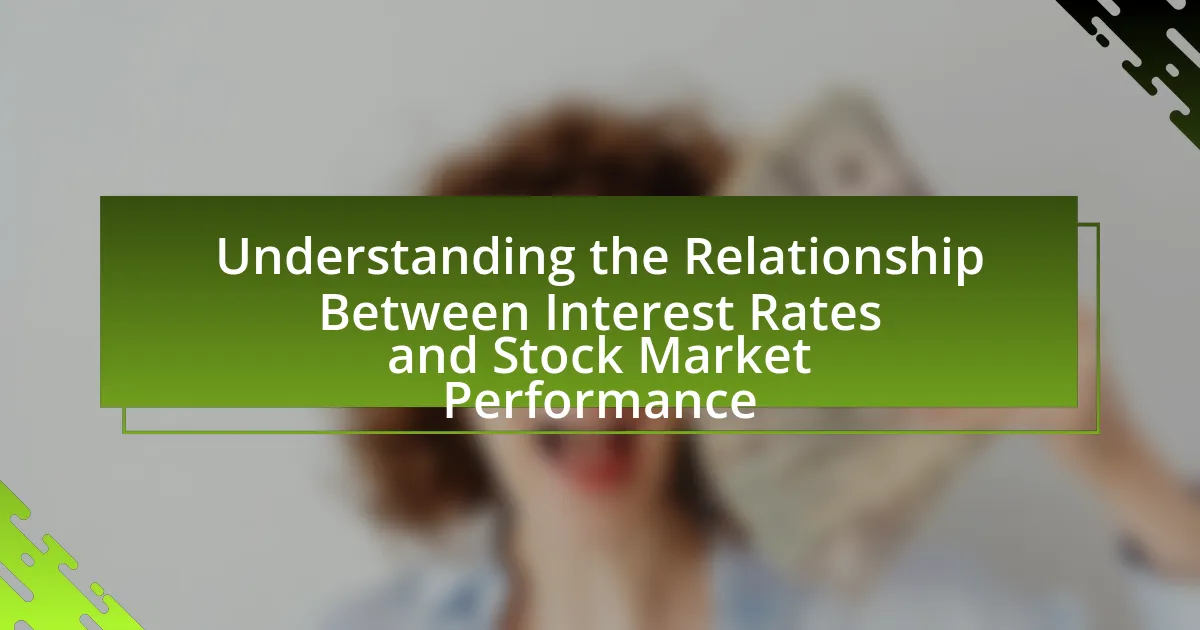The article examines the relationship between interest rates and stock market performance, highlighting the inverse correlation between the two. It explains how rising interest rates typically lead to declining stock prices due to increased borrowing costs and reduced consumer spending, while lower rates tend to stimulate economic growth and boost stock valuations. Key mechanisms connecting interest rates to stock prices, the influence of economic indicators, and the impact of central bank policies are discussed. Additionally, the article outlines strategies for investors to adapt to changing interest rates and emphasizes the importance of understanding this relationship for effective investment decision-making.

What is the relationship between interest rates and stock market performance?
Interest rates inversely affect stock market performance; as interest rates rise, stock prices typically decline. Higher interest rates increase borrowing costs for companies, leading to reduced consumer spending and lower corporate profits, which negatively impacts stock valuations. For instance, during the Federal Reserve’s rate hikes in 2018, the S&P 500 index experienced significant volatility and a decline, illustrating this relationship. Conversely, lower interest rates tend to stimulate economic growth and boost stock prices, as seen in the post-2008 financial crisis period when rates were kept near zero, contributing to a prolonged bull market.
How do interest rates influence stock market trends?
Interest rates significantly influence stock market trends by affecting borrowing costs and consumer spending. When interest rates rise, borrowing becomes more expensive, leading to reduced consumer spending and lower corporate profits, which can result in declining stock prices. Conversely, lower interest rates decrease borrowing costs, encouraging spending and investment, often leading to higher stock prices. Historical data shows that during periods of rising interest rates, such as the Federal Reserve’s actions in the late 1970s and early 1980s, stock markets experienced downturns, while periods of declining rates, like the early 2010s, correlated with stock market recoveries.
What mechanisms connect interest rates to stock prices?
Interest rates influence stock prices primarily through the cost of borrowing and the discount rate applied to future cash flows. When interest rates rise, borrowing costs increase for companies, which can lead to reduced capital expenditures and lower future earnings, negatively impacting stock prices. Conversely, lower interest rates decrease borrowing costs, encouraging investment and potentially boosting earnings, which can lead to higher stock prices.
Additionally, interest rates affect the discount rate used in valuation models; higher rates increase the discount rate, reducing the present value of future cash flows from stocks. For example, a study by Campbell and Shiller (1988) demonstrated that changes in interest rates significantly affect stock valuations, confirming the inverse relationship between interest rates and stock prices.
How do changes in interest rates affect investor behavior?
Changes in interest rates significantly influence investor behavior by altering the cost of borrowing and the attractiveness of various investment options. When interest rates rise, borrowing becomes more expensive, leading investors to favor safer assets like bonds over riskier equities, as higher yields on bonds become more appealing. Conversely, when interest rates fall, borrowing costs decrease, encouraging investors to seek higher returns in the stock market, which can lead to increased equity investments. Historical data from the Federal Reserve indicates that a 1% increase in interest rates can lead to a 10% decline in stock prices, demonstrating the sensitivity of investor behavior to interest rate fluctuations.
Why is understanding this relationship important for investors?
Understanding the relationship between interest rates and stock market performance is crucial for investors because it directly influences investment decisions and portfolio management. When interest rates rise, borrowing costs increase, which can lead to reduced consumer spending and lower corporate profits, negatively impacting stock prices. Conversely, lower interest rates typically stimulate economic growth, encouraging investment in equities. Historical data shows that during periods of rising interest rates, such as from 2004 to 2006, the S&P 500 experienced volatility, highlighting the importance of this relationship for strategic investment planning.
What risks do investors face if they ignore interest rate changes?
Investors face significant risks, including potential losses in portfolio value and reduced returns, if they ignore interest rate changes. When interest rates rise, borrowing costs increase, which can lead to lower consumer spending and reduced corporate profits, negatively impacting stock prices. For instance, a 1% increase in interest rates can lead to a decline in stock valuations by approximately 10% to 15%, as seen in historical market reactions during rate hikes by the Federal Reserve. Additionally, ignoring interest rate trends can result in missed opportunities for reallocating investments into more favorable assets, such as bonds, which may offer better yields in a rising rate environment.
How can knowledge of this relationship inform investment strategies?
Knowledge of the relationship between interest rates and stock market performance can significantly inform investment strategies by guiding asset allocation decisions. When interest rates rise, borrowing costs increase, which can lead to reduced consumer spending and lower corporate profits, often resulting in declining stock prices. Conversely, lower interest rates typically stimulate economic growth and can boost stock market performance. Historical data shows that during periods of rising interest rates, such as from 2015 to 2018, the S&P 500 experienced volatility, prompting investors to adjust their portfolios towards more defensive sectors. Understanding these dynamics allows investors to anticipate market movements and make informed decisions, optimizing their investment outcomes based on prevailing interest rate trends.

What factors affect the relationship between interest rates and stock market performance?
The relationship between interest rates and stock market performance is primarily influenced by economic growth, inflation expectations, and investor sentiment. Economic growth affects corporate earnings; when interest rates rise, borrowing costs increase, potentially slowing growth and negatively impacting stock prices. Inflation expectations play a crucial role as higher rates often signal attempts to control inflation, which can lead to reduced consumer spending and lower corporate profits. Additionally, investor sentiment can shift based on interest rate changes; for instance, rising rates may lead investors to favor fixed-income investments over equities, resulting in decreased demand for stocks. Historical data shows that during periods of rising interest rates, such as the late 1970s and early 1980s, stock market performance often declined, reinforcing the negative correlation between high interest rates and stock prices.
How do economic indicators play a role in this relationship?
Economic indicators significantly influence the relationship between interest rates and stock market performance by providing insights into economic health and investor sentiment. For instance, indicators such as GDP growth, unemployment rates, and inflation rates help investors gauge the overall economic environment. When economic indicators show strong growth, interest rates may rise as central banks attempt to control inflation, which can lead to decreased stock market performance due to higher borrowing costs. Conversely, weak economic indicators may prompt lower interest rates, encouraging investment in stocks as borrowing becomes cheaper. Historical data supports this; for example, during the 2008 financial crisis, declining economic indicators led to reduced interest rates, which initially boosted stock market recovery.
What specific economic indicators should investors monitor?
Investors should monitor key economic indicators such as interest rates, inflation rates, unemployment rates, GDP growth, and consumer confidence indices. Interest rates directly influence borrowing costs and investment decisions, impacting stock market performance; for instance, a rise in interest rates typically leads to lower stock prices as borrowing becomes more expensive. Inflation rates indicate the purchasing power of consumers and can affect corporate profits; historically, high inflation has correlated with reduced stock market returns. Unemployment rates provide insight into economic health; lower unemployment often signals a robust economy, which can boost investor confidence and stock prices. GDP growth reflects the overall economic activity and health, with higher growth rates generally leading to positive stock market performance. Lastly, consumer confidence indices gauge consumer sentiment, which can drive spending and investment, influencing stock market trends.
How do these indicators correlate with interest rate changes?
Interest rate changes correlate with economic indicators such as inflation, unemployment rates, and GDP growth. When inflation rises, central banks often increase interest rates to control price levels, which can lead to decreased consumer spending and lower stock market performance. Conversely, lower unemployment rates typically indicate a strong economy, prompting central banks to raise rates to prevent overheating, which can also negatively impact stock prices. Historical data shows that during the 2008 financial crisis, the Federal Reserve lowered interest rates to stimulate the economy, resulting in a significant rebound in stock market performance as economic indicators improved. Thus, the relationship between these indicators and interest rate changes is significant and can influence market dynamics.
What external factors can influence both interest rates and stock markets?
External factors that can influence both interest rates and stock markets include inflation, economic growth, and central bank policies. Inflation affects interest rates as central banks often raise rates to combat rising prices, which can lead to decreased stock market performance due to higher borrowing costs for companies. Economic growth influences interest rates as stronger growth can lead to higher demand for credit, prompting central banks to increase rates, while also boosting stock market performance through increased corporate earnings. Central bank policies, such as changes in the federal funds rate, directly impact interest rates and investor sentiment, subsequently affecting stock market valuations. For example, when the Federal Reserve raised interest rates in 2018, stock markets experienced volatility as investors adjusted their expectations for future corporate profits.
How do geopolitical events impact interest rates and stock performance?
Geopolitical events significantly influence interest rates and stock performance by creating uncertainty in financial markets. For instance, when tensions arise, such as during conflicts or trade disputes, central banks may adjust interest rates to stabilize the economy, often lowering them to encourage borrowing and investment. This was evident during the 2008 financial crisis when the Federal Reserve reduced rates to near-zero levels in response to economic instability.
Simultaneously, stock markets typically react negatively to geopolitical uncertainty, as investors may sell off shares due to fears of economic downturns. For example, the stock market experienced sharp declines during the onset of the COVID-19 pandemic, driven by geopolitical concerns about global supply chains and economic shutdowns. Historical data shows that major geopolitical events, like the Gulf War or Brexit, have led to increased volatility in stock prices, reflecting investor sentiment and risk aversion.
Thus, geopolitical events can lead to lower interest rates as a monetary policy response while simultaneously causing declines in stock performance due to heightened uncertainty and risk.
What role does central bank policy play in this dynamic?
Central bank policy plays a crucial role in influencing interest rates, which directly impacts stock market performance. By adjusting the benchmark interest rates, central banks can either stimulate or cool down economic activity; for instance, lowering rates typically encourages borrowing and investment, leading to higher stock prices, while raising rates can have the opposite effect. Historical data shows that during the 2008 financial crisis, the Federal Reserve slashed interest rates to near zero to support the economy, which subsequently contributed to a significant recovery in stock market indices. This demonstrates that central bank policy is a key driver in the dynamic relationship between interest rates and stock market performance.

How can investors leverage the relationship between interest rates and stock market performance?
Investors can leverage the relationship between interest rates and stock market performance by adjusting their investment strategies based on interest rate trends. When interest rates rise, borrowing costs increase, which can lead to lower consumer spending and reduced corporate profits, often resulting in declining stock prices. Conversely, when interest rates fall, borrowing becomes cheaper, stimulating economic growth and potentially boosting stock prices. Historical data shows that during periods of low interest rates, such as the post-2008 financial crisis, stock markets generally experienced significant gains, with the S&P 500 rising over 400% from 2009 to 2021. By monitoring interest rate changes and understanding their impact on economic conditions, investors can make informed decisions about when to buy or sell stocks, thereby optimizing their investment returns.
What strategies can investors use to adapt to changing interest rates?
Investors can adapt to changing interest rates by diversifying their portfolios, focusing on interest rate-sensitive sectors, and utilizing fixed-income securities. Diversification helps mitigate risks associated with rate fluctuations by spreading investments across various asset classes, such as stocks, bonds, and real estate. For instance, during periods of rising interest rates, sectors like financials often benefit, while utilities may underperform. Additionally, investors can consider short-duration bonds, which are less sensitive to interest rate changes, thereby reducing potential losses. Historical data shows that in the past, sectors such as consumer discretionary and technology have performed well in low-interest environments, while defensive sectors like utilities and consumer staples tend to do better when rates rise.
How can diversification help mitigate risks associated with interest rate fluctuations?
Diversification can mitigate risks associated with interest rate fluctuations by spreading investments across various asset classes, which reduces the impact of rate changes on a portfolio. When interest rates rise, bond prices typically fall, but equities or real estate may perform differently, thus balancing overall portfolio performance. Historical data shows that a diversified portfolio can reduce volatility; for instance, during the 2008 financial crisis, diversified portfolios experienced less severe losses compared to concentrated investments. This evidence supports the effectiveness of diversification in managing interest rate risk.
What types of investments are more resilient to interest rate changes?
Investments in real estate, commodities, and inflation-protected securities are more resilient to interest rate changes. Real estate often appreciates in value and generates rental income, which can offset rising interest costs. Commodities, such as gold, tend to retain value during inflationary periods, making them a hedge against interest rate hikes. Inflation-protected securities, like Treasury Inflation-Protected Securities (TIPS), adjust their principal based on inflation, providing a safeguard against the eroding purchasing power that can accompany rising rates. Historical data shows that during periods of increasing interest rates, these asset classes have demonstrated relative stability compared to traditional fixed-income investments.
What are common pitfalls investors should avoid regarding interest rates?
Common pitfalls investors should avoid regarding interest rates include failing to anticipate interest rate changes, which can significantly impact investment returns. Investors often overlook the inverse relationship between bond prices and interest rates; when rates rise, bond prices typically fall, leading to potential losses. Additionally, many investors neglect to consider the timing of interest rate hikes, which can affect market sentiment and stock valuations. Historical data shows that during periods of rising interest rates, such as the Federal Reserve’s actions in 2018, stock market volatility increased, highlighting the importance of being aware of interest rate trends. Lastly, investors frequently misjudge the impact of interest rates on sectors; for instance, higher rates can adversely affect real estate and utilities, sectors that are sensitive to borrowing costs.
How can overreacting to interest rate news negatively impact investment decisions?
Overreacting to interest rate news can lead to impulsive investment decisions that may result in financial losses. Investors who react strongly to interest rate changes often sell off assets in a panic, causing stock prices to drop unnecessarily. For instance, a study by the National Bureau of Economic Research found that markets can overreact to interest rate announcements, leading to mispricing of stocks. This mispricing can create opportunities for savvy investors, but those who overreact may miss out on potential gains as the market corrects itself. Additionally, emotional trading can result in a failure to adhere to long-term investment strategies, which are typically more beneficial than short-term reactions to market fluctuations.
What are the best practices for staying informed about interest rate trends?
To stay informed about interest rate trends, regularly monitor central bank announcements and economic indicators. Central banks, such as the Federal Reserve in the United States, provide insights into monetary policy decisions that directly affect interest rates. Economic indicators like inflation rates, employment data, and GDP growth also influence these trends. For example, the Federal Reserve’s interest rate hikes in response to rising inflation rates have historically impacted stock market performance, as seen during the 2015-2018 period when gradual rate increases were implemented. Additionally, subscribing to financial news outlets and utilizing economic calendars can provide timely updates on interest rate changes and forecasts, ensuring that investors remain aware of potential market impacts.



